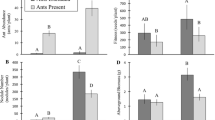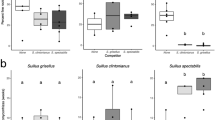Summary
Physically intimate interactions between organisms are assumed to be highly specific, yet intimate mutualisms exhibiting little specificity are common and important in many communities. We compare host records for ectomycorrhizal fungi (mutualists) to those for biotrophic shoot fungi and necrotrophic root fungi (both antagonists) in order to test two alternative predictions: (1) intimate physical associations (biotrophy) are more specific than less intimate ones (necrotrophy); (2) antagonisms are more specific than mutualisms. Specificity of fungi for hosts supports prediction (1): ectomycorrhizal fungi and shoot biotrophs are more host specific than root necrotrophs. Fungal symbiont ranges of hosts supports prediction (2): woody hosts are associated with a greater number of mutualistic fungi than antagonistic fungi. The numbers of fungi in the three groups infecting hosts are all significantly positively correlated. This result suggests that some hosts are resistant to fungal invasion and others are quite susceptible. Thus, plants may not be able to erect selective barriers to only antagonistic fungi. The marked asymmetry of specificity from the perspectives of hosts vs fungi suggests that evolutionary and ecological processes act differently on partners in symbioses.
Similar content being viewed by others
References
Anderson, A. J. (1988) Mycorrhizae-Host specificity and recognition.Phytopath. 78, 375–8.
Fitter, A. H. (1985) Functioning of vesicular-arbuscular mycorrhizas under field condition.New Phytol. 99, 257–65.
Garrett, S. D. (1960)Biology of root-infecting fungi. Cambridge University Press, NY, USA.
Garrett, S. D. (1979) The soil-root interface in relation to disease. InThe soil-root interface (J. L. Harley and R. S. Russell, eds) pp. 301–28. Academic Press, NY, USA.
Gregory, R. D. (1990) Parasites and host geographic range as illustrated by waterfowl.Func. Ecol. 4, 645–54.
Harley, J. L. (1989) The significance of mycorrhiza.Mycol. Res. 92, 129–39.
Harley, J. L. and Smith, S. E. (1983)Mycorrhizal symbiosis. Academic Press, NY, USA.
Holmes, J. C. (1983) Evolutionary relationships between parasitic helminths and their hosts. In:Coevolution (D. J. Futuyma and M. Slatkin, eds) pp. 161–85. Sinauer, NY, USA.
Hudson, H. J. (1986)Fungal Biology. Edward Arnold, London, UK.
Johnson, R. (1975) Genetics of host-parasite interactions. InSpecificity in plant diseases (R. K. S. Wood and A. Graniti, eds) pp. 45–62. Plenum Press, New York, USA.
Jordano, P. (1987) Patterns of mutualistic interaction in pollination and seed dispersal: connectance, dependence asymmetries, and coevolution.Am. Nat. 129, 657–77.
Karban, R., Adamchak, R. and Schnathorst, W. C. (1987) Induced resistance and interspecific competition between spider mites and a vascular wilt fungus.Science 235, 678–80.
Law, R. (1985) Evolution in a mutualistic environment. In:The biology of mutualism: Ecology and Evolution (D. H. Boucher, ed.) pp. 145–70. Oxford University Press, NY, USA.
Law, R. (1988) Some ecological properties of mutualisms involving plants. InPlant population ecology, the 28th symposium of the British Ecological Society (A. J. Davy, M. J. Hutchings and A. R. Watkinson, eds) pp. 315–41. Blackwell Scientific Publications, Oxford, UK.
Lewis, D. H. (1973) Concepts in fungal nutrition and the origin of biotrophy.Biol. Rev. 48, 261–73.
Malloch, D. W., Pirozynski, K. A. and Raven, P. H. (1980) Ecological and evolutionary significance of mycorrhizal symbioses in vascular plants (A Review).Proc. Natl Acad. Sci USA 77, 2113–8.
Marks, G. C. and Foster, R. C. (1973) Structure, morphogenesis and ultrastructure of ectomycorrhizae. In:Ectomycorrhizae: their ecology and physiology (G. C. Marks and T. T. Kozlowski, eds) pp. 1–41. Academic Press, NY, USA.
Mosse, B., Stribley, D. P. and LeTacon, F. (1981) Ecology of mycorrhizae and mycorrhizal fungi. In:Advances in microbiol ecology (M. Alexander, ed.) pp. 137–210. Plenum Press, NY, USA.
Nelson, R. R. (1979) Some thoughts on coevolution of plant pathogenic fungi and their hosts. In:Host-Parasite interfaces (B. B. Nickol, ed.) pp. 17–25. Academic Press, NY, USA.
Price, P. W. (1980)Evolutionary biology of parasites. Princeton University Press, Princeton, NJ, USA.
Read, C. P. (1970)Parasitism and symbiology: an introductory text. Ronald Press, NY, USA.
SAS Institute, Inc. (1987)SAS/STAT Guide for personal computers, version 6 edition. SAS Institute, Inc., Cary, NC, USA.
Sequeira, L. (1979) Recognition between plant hosts and parasites. InHost-parasite interfaces (B. B. Nickol ed.) pp. 71–84. Academic Press, NY, USA.
Strong Jr, D. R. and Levin, D. A. (1975) Species richness of the parasitic fungi of British trees.Proc. Natl Acad. Sci. USA 72, 2116–9.
Author information
Authors and Affiliations
Rights and permissions
About this article
Cite this article
Borowicz, V.A., Juliano, S.A. Specificity in host-fungus associations: Do mutualists differ from antagonists?. Evol Ecol 5, 385–392 (1991). https://doi.org/10.1007/BF02214155
Issue Date:
DOI: https://doi.org/10.1007/BF02214155




